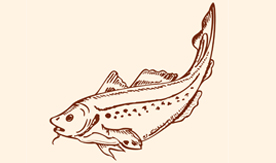
Pacific Cod as Paleothermometers
Otoliths of prehistoric Pacific cod function as paleothermometers, revealing how the species endured fluctuating ocean temperatures 500 years ago during the Little Ice Age, according to a research team led by a University of Maine anthropologist.
Fish have three pair of otoliths or ear stones — calcium carbonate structures found in the inner ear that are used for acoustic perception and balance. In Pacific cod, the largest and most useful for oxygen isotope analysis is the sagittae, which grows in daily, seasonal and yearly bands, much like tree rings. These growth rings can be counted to estimate the age of the fish and sampled to understand such factors as changes in the environment.
The sagittae’s size also increases the odds of it being preserved in the archaeological record.
Catherine West, a UMaine assistant professor of anthropology and climate change, has used oxygen isotopes in Pacific cod otoliths to reconstruct Little Ice Age ocean conditions and to assess the relationship among climate, fish biogeography and human foraging activity in the Gulf of Alaska.
Because oxygen isotope ratios in otolith growth bands are determined primarily by water temperature, West studies the growth rings as paleothermometers to understand conditions during the Little Ice Age.
Pacific cod are found throughout the North Pacific Ocean, from China’s Yellow Sea to Monterey Bay, California. The broad temporal and geographic distribution of Pacific cod makes their otoliths ideal for paleoenvironmental reconstruction.
For her most recent study of otoliths as paleothermometers, West and researchers from the Seattle-based International Pacific Halibut Commission and the National Marine Fisheries Service analyzed ear stones found at an archaeological site on Kodiak Island, Alaska. The site was occupied during the Little Ice Age that began in the Gulf of Alaska approximately 650 years ago. The 15 whole otoliths selected from the deposits representing a 500-year period clearly indicated that the Pacific cod living around the Kodiak archipelago experienced fluctuations in ocean temperature during the Little Ice Age.
The archaeological otoliths offer a long-term record of Pacific cod’s environmental interaction, contributing to understanding of the species’ survival in the face of changing climate in the North Pacific, according to the researchers writing in the Journal of Archaeological Science.
Contact: Margaret Nagle, 207.581.3745
